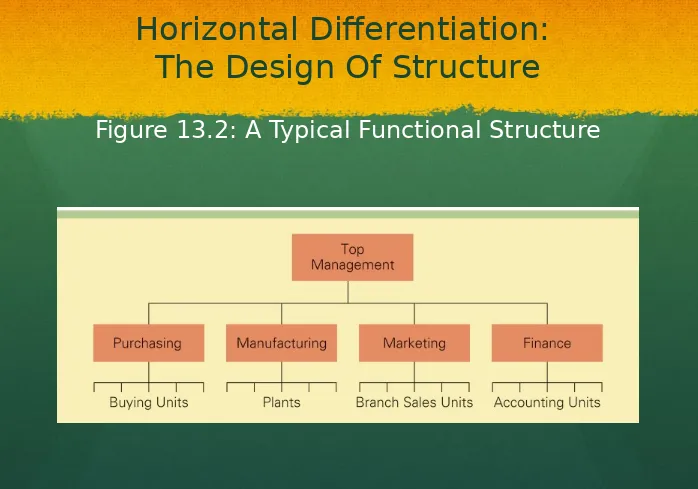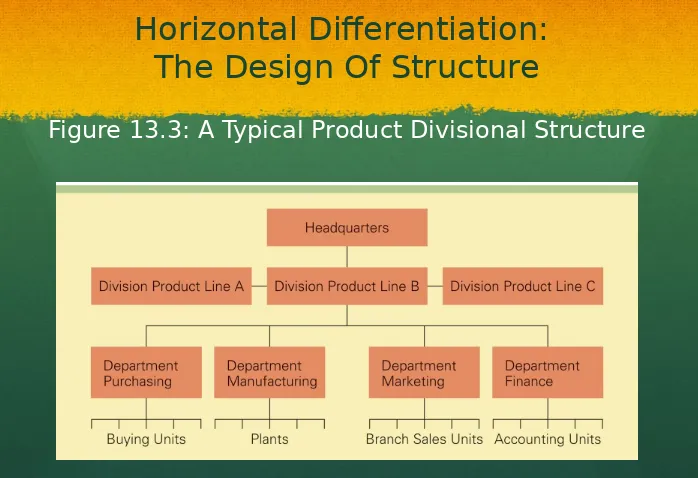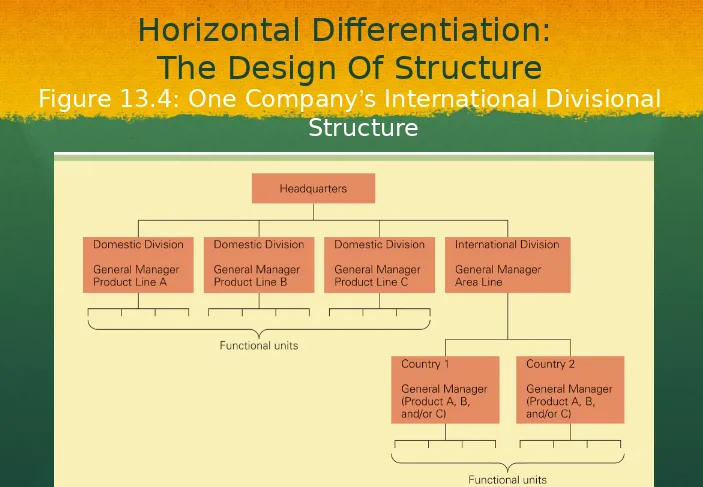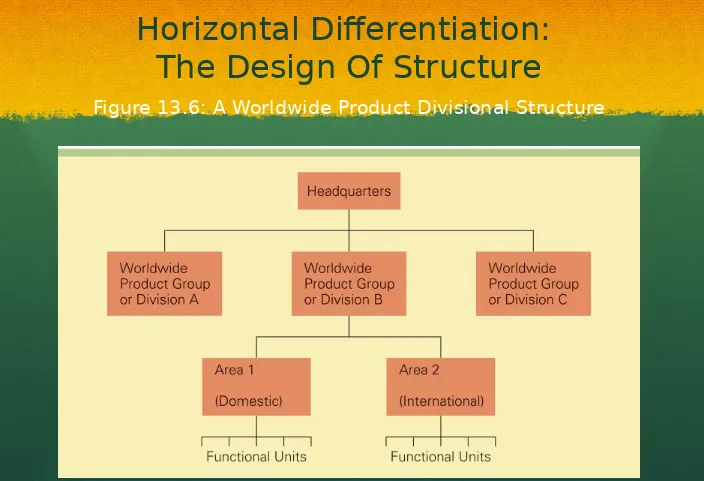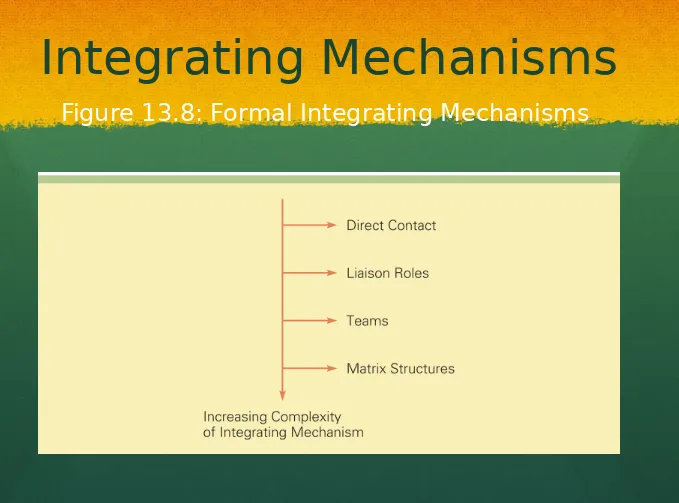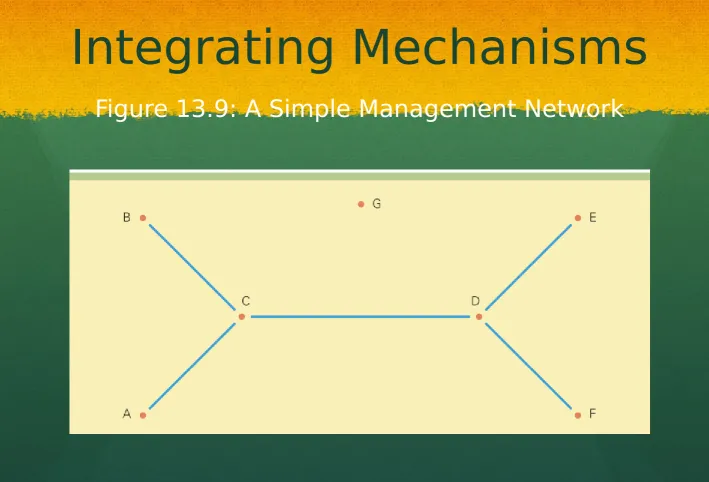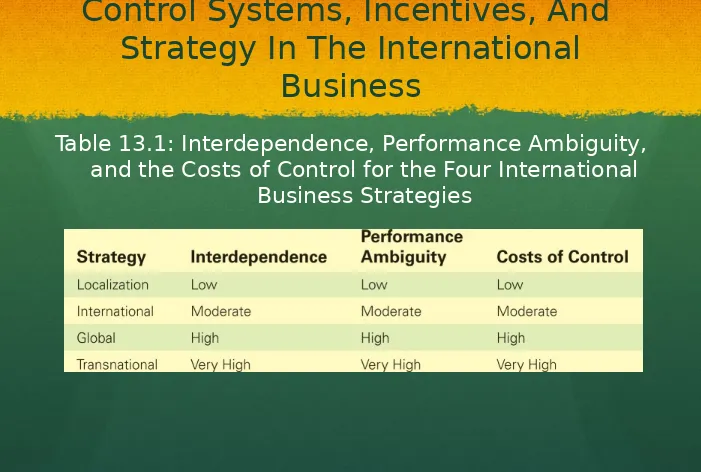The Organizational of
International Business
Introduction
Organizational architecture refers to the totality of a
firm’s organization, including formal organization
structure, control systems and incentives, processes, organizational culture, and people
To be the most profitable, firms need to be sure:
the diferent elements of the organizational architecture are internally consistent
the organizational architecture matches or fits the strategy of the firm
the strategy and architecture of the firm are consistent with each other, and consistent with competitive
Organizational
Architecture
Organizational structure refers to:
the formal division of the organization into subunits
the location of decision-making responsibilities within that
structure (centralized versus decentralized)
the establishment of integrating mechanisms to coordinate
the activities of subunits including cross-functional teams or pan-regional committees
Control systems are the metrics used to measure
Organizational
Architecture
Incentives are the devices used to reward appropriate managerial behavior
Processes are the manner in which decisions are made and work is performed within the organization
Organizational culture refers to the norms and value systems that are shared among the employees of an organization
People refers to not just the employees of the
organization, but also the strategy used to recruit, compensate, and retain those individuals and the
Organizational
Structure
Organizational structure has three
dimensions:
1. Vertical diferentiation - the location of decision-making responsibilities within a structure
2. Horizontal diferentiation - the formal
division of the organization into sub-units
Vertical Diferentiation:
Centralization And Decentralization
Vertical diferentiation determines where
decision-making power is concentrated
Centralized decision-making:
facilitates coordination
ensure decisions consistent with organization’s objectives
gives top-level managers the means to bring about organizational change
Vertical Diferentiation:
Centralization And Decentralization
Decentralized decision-making:
relieves the burden of centralized decision-making
has been shown to motivate individuals
permits greater feeibility
can result in better decisions
can increase control
It can be worthwhile to centralize some decisions and
decentralize others
Horizontal Diferentiation:
The Design Of Structure
Horizontal diferentiation is concerned with
how the firm decides to divide itself into sub-units
The decision is usually based on:
function
type of business
Horizontal Diferentiation:
The Design Of Structure
Most firms begin with no formal structure
As they grow, the organization is split into functions
refecting the firm’s value creation activities (functional structure)
The functions are typically coordinated and controlled by
top management
Decision-making tends to be centralized
If the firm diversifies its product line, further horizontal
diferentiation may be necessary
Firms may switch to a product divisional structure where
Horizontal Diferentiation:
The Design Of Structure
Horizontal Diferentiation:
The Design Of Structure
Horizontal Diferentiation:
The Design Of Structure
When firms eepand internationally, they often group all of their international activities into an international division
In time it might prove viable to manufacture the product in each country
The result could be that firms with a functional structure at home would replicate the functional structure in every country in which they do business and firms with a
divisional structure would replicate the divisional structure in every country in which they do business
Horizontal Diferentiation:
The Design Of Structure
Horizontal Diferentiation:
The Design Of Structure
Many firms that continue to eepand will abandon their international division structure and move to either a:
Worldwide product divisional structure - tends to
be adopted by diversified firms that have domestic product division
Worldwide area structure - tends to be adopted
by undiversified firms whose domestic structures are based on functions
Horizontal Diferentiation:
The Design Of Structure
The worldwide area structure:
is favored by firms with low degree of diversification
and a domestic structure based on function
divides the world into autonomous geographic areas
decentralizes operational authority
facilitates local responsiveness
can result in a fragmentation of the organization
Horizontal Diferentiation:
The Design Of Structure
The worldwide product division structure:
is adopted by firms that are reasonably diversified
allows for worldwide coordination of value creation
activities of each product division
helps realize location and eeperience curve
economies
facilitates the transfer of core competencies
Horizontal Diferentiation:
The Design Of Structure
Horizontal Diferentiation:
The Design Of Structure
The global matrie structure is an attempt to minimize the
limitations of the worldwide area structure and the worldwide product divisional structure
The global matrie structure:
allows for diferentiation along two dimensions - product
division and geographic area
has dual decision–making - product division and geographic
area have equal responsibility for operating decisions
can be bureaucratic and slow
can result in confict between areas and product divisions
can result in finger-pointing between divisions when something
Integrating Mechanisms
Regardless of the type of structure, firms need a mechanism to integrate subunits
The need for coordination is lowest in firms with a
localization strategy and highest in transnational firms
Coordination can be complicated by diferences in subunit orientation and goals
The simplest formal integrating mechanism is direct contact between subunit managers, followed by liaisons
Temporary or permanent teams composed of individuals from each subunit is the neet level of formal integration
Integrating Mechanisms
Many firms are using informal integrating mechanisms
A knowledge network is a network for transmitting
information within an organization that is based not on formal organization structure, but on informal
contacts between managers within an enterprise and on distributed information systems
A knowledge network is a non bureaucratic conduit for
knowledge fows
To be successful, a knowledge network must embrace
Controls Systems And
Incentives
A firm’s leaders need to ensure that the
actions of subunits are consistent with the firm’s overall strategic and financial
objectives
This is achieved through control and incentive
Types Of Control
Systems
There are four main types of control systems:
1. Personal controls – control by personal contact with subordinates
Most widely used in small firms
2. Bureaucratic controls – control through a system of rules and procedures that directs the actions of subunits
The most important bureaucratic controls are
Types Of Control
Systems
3. Output controls – setting goals for subunits to achieve and eepressing those goals in terms of relatively objective performance metrics
Control is achieved by comparing actual
performance against targets and intervening selectively to take corrective action
4. Cultural controls – eeist when employees “buy into” the norms and value systems of the firm
Firms with strong culture have less need for other
Incentive Systems
Incentives are the devices used to reward behavior
Incentives are usually closely tied to performance metrics used for output controls
Incentives:
should vary depending on the employee and the nature of the work being performed
should promote cooperation between managers in sub-units
should refect national diferences in institutions and culture
Control Systems, Incentives, And
Strategy In The International
Business
The key to understanding the relationship
between international strategy, control systems and incentive systems is
performance ambiguity - which eeists when the causes of a subunit’s poor performance are not clear
The cost of control rises as performance
Control Systems, Incentives, And
Strategy In The International
Business
Performance ambiguity:
is common when a subunit’s performance is
dependent on the performance of other subunits
is lowest in firms with a localization strategy
higher in international firms
still higher in firms with a global standardization
strategy
Control Systems, Incentives, And
Strategy In The International
Business
Table 13.1: Interdependence, Performance Ambiguity, and the Costs of Control for the Four International
Processes
Processes refer to the manner in which
decisions are made and work is performed
Many processes cut across national
boundaries as well as organizational boundaries
Processes can be developed anywhere within
a firm’s global operations network
Formal and informal integrating mechanisms
Organizational Culture
Culture refers to a systems of values and
norms that are shared among people
Organizations have their own values and
norms that employees are encouraged to follow
Organizational culture tends to change very
Creating And Maintaining
Organizational Culture
Organizational culture comes from:
founders and important leaders
national social culture
the history of the enterprise
decisions that resulted in high performance
Organizational culture can be maintained through:
hiring and promotional practices
reward strategies
socialization processes
Organizational Culture And
Performance
In The International Business
Managers in companies with a “strong” culture share a
relatively consistent set of values and norms that have a clear impact on the way work is performed
A “strong” culture:
is not always good
may not lead to high performance
could be beneficial at one point, but not at another
Companies with adaptive cultures have the highest
Synthesis: Strategy And
Architecture
What is the interrelationship between the four
basic strategies (localization, international,
Synthesis: Strategy And
Architecture
Localization Strategy
Firms pursuing a localization strategy focus on local responsiveness.
They do not have a high need for integrating
mechanisms
Performance ambiguity and the cost of
control tends to be low
International Strategy
Firms pursuing an international strategy create value by transferring core competencies from home to foreign subsidiaries.
The need for control is moderate
The need for integrating mechanisms is moderate
Performance ambiguity is relatively low and so is
the cost of control
The worldwide product division structure is
Global Standardization
Strategy
Firms pursuing a global standardization strategy focus on the realization of location and
eeperience curve economies.
Headquarters maintains control over most
decisions
The need for integrating mechanisms is high
Strong organizational cultures are
encouraged
Transnational Strategy
Firms pursuing a transnational strategy focus on
simultaneously attaining location and eeperience curve economies, local responsiveness, and global learning.
Some decisions are centralized and others are decentralized
The need for coordination is high
An array of formal and informal integrating mechanism are used
The cost of control is high
A strong culture is encouraged
Environment, Strategy,
Architecture, And Performance
For a firm to succeed, two conditions must be met:
1. the firm’s strategy must be consistent with the environment in which the firm operates
Organizational Change
Firms need to change their architecture to
Organizational Inertia
Organizations are difcult to change
Sources of inertia include:
the eeisting distribution of power and infuence
the current culture
senior managers’ preconceptions about the
appropriate business model or paradigm
Implementing
Organizational Change
There are three basic principles for successful organization change:
1. Unfreeze the organization through shock therapy
Efective change requires taking bold actions like plant closures or dramatic structural reorganizations
2. Moving the organization to a new state through proactive change in architecture
Movement requires a substantial change in the form of a firm’s organizational architecture so that it matches the desired new strategic posture
Movement should be done quickly
3. Refreeze the organization in its new state
